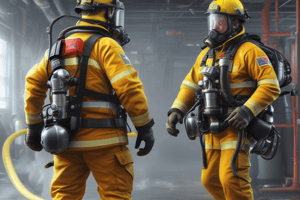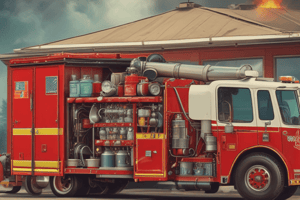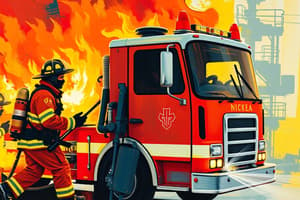Podcast
Questions and Answers
What is considered the most important component of the overall response time for fire rescue departments?
What is considered the most important component of the overall response time for fire rescue departments?
- Dispatch Time
- Station Turnout Time (correct)
- Apparatus Response
- Special Operations
Which NFPA standard outlines the organization and deployment of fire suppression operations?
Which NFPA standard outlines the organization and deployment of fire suppression operations?
- NFPA 1710 (correct)
- NFPA 1730
- NFPA 1720
- NFPA 1700
At what point does turnout time begin?
At what point does turnout time begin?
- When the unit acknowledges the alarm (correct)
- When the unit arrives at the incident
- When the unit starts moving towards the scene
- When the unit is notified of the alarm
What does the response time end with?
What does the response time end with?
During the procedure, which action should the Officer-in-Charge NOT do when responding to an alarm?
During the procedure, which action should the Officer-in-Charge NOT do when responding to an alarm?
What type of incidents does 'Special Operations' refer to?
What type of incidents does 'Special Operations' refer to?
What is the role of the Fire Rescue Dispatcher (FRD) in response time?
What is the role of the Fire Rescue Dispatcher (FRD) in response time?
Which statement about the acknowledgement of an alarm is incorrect?
Which statement about the acknowledgement of an alarm is incorrect?
What is the recommended target turnout time for fire and special operations responses?
What is the recommended target turnout time for fire and special operations responses?
Who is responsible for notifying the Fire Alarm Office (FAO) of a more appropriate unit for response in the case of territory disputes?
Who is responsible for notifying the Fire Alarm Office (FAO) of a more appropriate unit for response in the case of territory disputes?
What action should be taken by personnel before starting to respond to alarms?
What action should be taken by personnel before starting to respond to alarms?
When multiple tailboard firefighters respond, who is responsible for closing the apparatus bay door?
When multiple tailboard firefighters respond, who is responsible for closing the apparatus bay door?
What should be activated if available, before mounting the apparatus?
What should be activated if available, before mounting the apparatus?
What must the Officer In Charge (OIC) ensure prior to responding to alarms?
What must the Officer In Charge (OIC) ensure prior to responding to alarms?
In what way should the apparatus be driven to the incident?
In what way should the apparatus be driven to the incident?
What should all on-duty personnel maintain to ensure effective response times?
What should all on-duty personnel maintain to ensure effective response times?
Flashcards are hidden until you start studying
Study Notes
Key Performance Indicators for Fire Rescue
- Unit response times serve as essential indicators for evaluating fire rescue departments’ effectiveness.
- Quick and safe alarm responses are prioritized for maintaining overall short response times.
Components of Response Time
- Apparatus Response: Movement of the apparatus towards the alarm's location.
- Dispatch Time: Notification period from the Fire Rescue Dispatcher (FRD) to the unit about the alarm.
- Response Time: Starts when a unit begins its response and concludes upon arrival.
- Turnout Time: Interval from acknowledgment of an alarm to the unit's actual response.
National Standards
- NFPA 1710: Sets guidelines for the organization and deployment of fire and emergency services by career departments.
Alarm Receiving and Response Procedures
- Unit Officer-in-Charge (OIC): Responsible for acknowledging alarms and ensuring rapid crew response and accountability before departure.
- Driver/Operator: Starts the apparatus, exits safely from the bay, and coordinates with the OIC on route.
- Tailboard Firefighter: Activates traffic pre-emption systems and dons personal protective equipment (PPE) in preparation for the response.
Communication and Readiness
- OIC must confirm radio communications with the FRD and update status on Mobile Computer Units (MCUs).
- Recommended target turnover times:
- 80 seconds for fire and special operations.
- 60 seconds for EMS responses.
Safety and Security Protocols
- Station security must be verified before any response.
- In case of territory disputes, the initially dispatched unit must respond immediately while notifying the FAO for reassessment.
- Significant delays in response must be reported to the FAO.
Handling Operational Conflicts
- If multiple units are dispatched to different alarms in proximity, the OIC should alert the FRD for efficient resource allocation.
- The chain of communication involving the FAO is activated for incidents not directly reported to them, detailing nature, address, responding units, and resource needs.
Studying That Suits You
Use AI to generate personalized quizzes and flashcards to suit your learning preferences.




